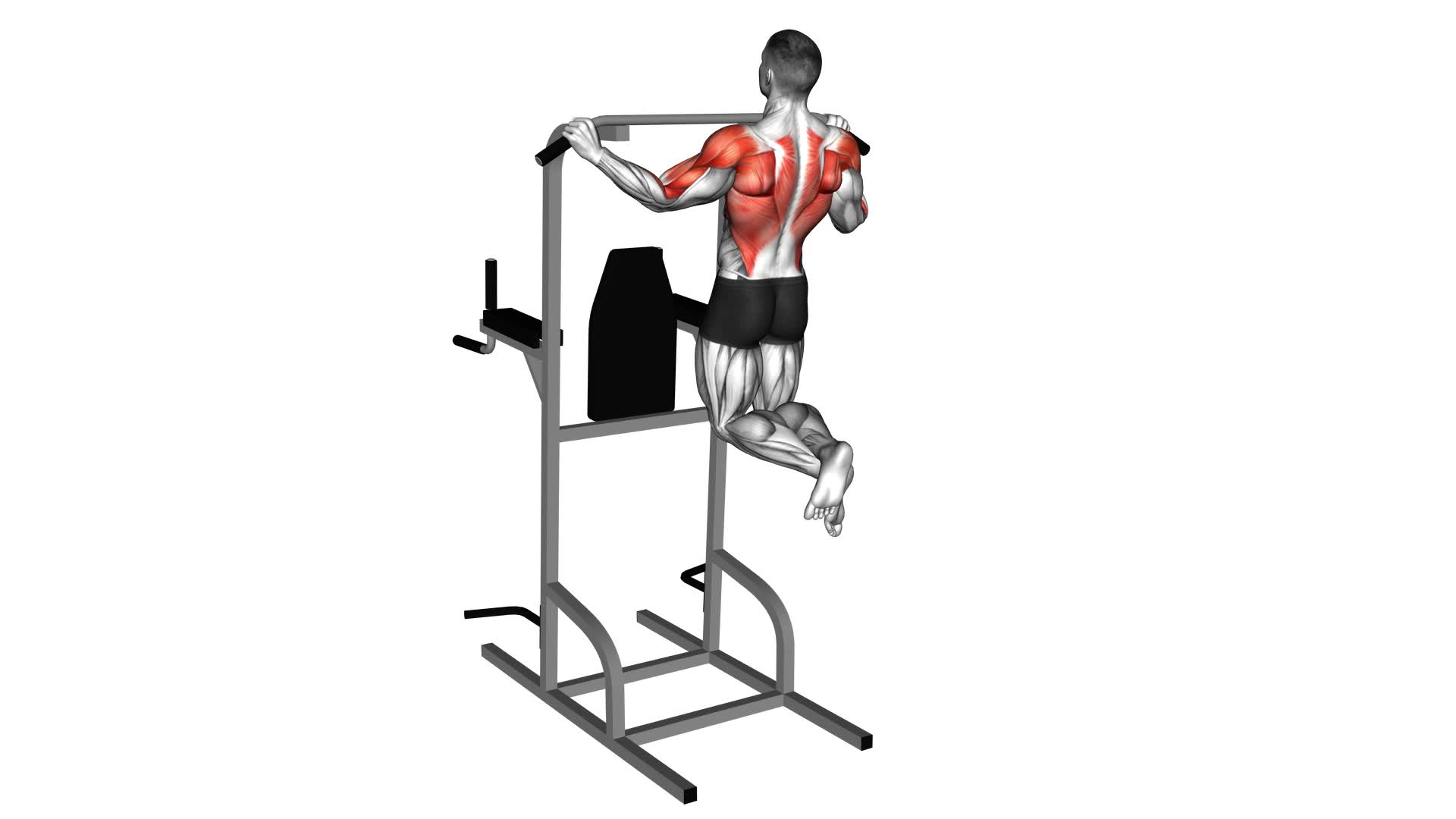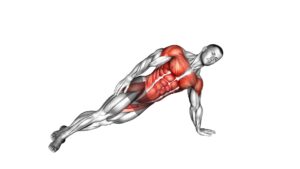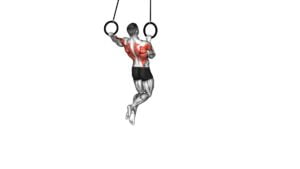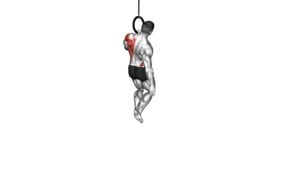Corn Cob (Side to Side) Pull-up (male) – Video Exercise Guide & Tips

Looking to level up your upper body strength? The Corn Cob Pull-up is the perfect exercise for you. In this video exercise guide, we'll show you the proper form and technique to perform this challenging movement.
Watch This Exercise Video
Whether you're a beginner or advanced, we've got modifications and progressions to suit your fitness level. Avoid common mistakes and maximize your results with our expert tips.
Get ready to take your pull-up game to the next level with the Corn Cob Pull-up.
Key Takeaways
- The Corn Cob Pull-Up is highly effective for improving upper body strength and targets multiple muscle groups.
- Proper form and core engagement are essential for maximizing results with the Corn Cob Pull-Up.
- The exercise can be modified and progressed to suit different fitness levels and increase intensity.
- Engaging the core muscles throughout the exercise improves overall strength, stability, and control.
Benefits of the Corn Cob Pull-up
You should regularly incorporate the Corn Cob Pull-up into your workout routine to maximize its benefits. This exercise is highly effective for improving upper body strength. The Corn Cob Pull-up targets multiple muscle groups, including the back, shoulders, and arms, making it a great addition to any strength training program.
One of the key benefits of the Corn Cob Pull-up is its ability to engage and strengthen the muscles in your upper body. By pulling yourself up using a wide grip and alternating from side to side, you're challenging your back and shoulder muscles in a unique way. This exercise can help you develop a stronger and more defined upper body.
Additionally, the Corn Cob Pull-up offers variations that can further enhance your workout. You can adjust the difficulty level by using different hand positions, such as a close grip or a wide grip. You can also incorporate weighted vests or resistance bands to increase the intensity of the exercise.
Incorporating the Corn Cob Pull-up into your workout routine can lead to significant improvements in your upper body strength. By regularly challenging your muscles with this exercise and its variations, you can achieve a stronger and more muscular upper body.
Equipment Needed for the Exercise
To perform the Corn Cob (Side to Side) Pull-up, you'll need essential exercise equipment such as a pull-up bar or a suspension trainer. These tools provide the necessary stability and support for executing the exercise correctly.
While there are no direct alternatives for this specific equipment, you can explore variations or modifications that target similar muscle groups if you don't have access to the recommended equipment.
Essential Exercise Equipment
To perform the Corn Cob (Side to Side) Pull-up exercise, you'll need a sturdy pull-up bar. This is an essential piece of exercise equipment that will help you effectively execute the exercise and reap its benefits.
Here are some different types of essential exercise equipment that can enhance your workout routine:
- Pull-up bar: Provides a stable and secure grip for performing the Corn Cob (Side to Side) Pull-up exercise.
- Resistance bands: Can be attached to the pull-up bar to provide additional resistance and challenge your muscles.
- Weighted vest: Adds extra weight to increase the intensity of the exercise and build strength.
Having the right equipment is crucial for maximizing the benefits of your workout. By utilizing a pull-up bar, resistance bands, and a weighted vest, you can enhance your Corn Cob (Side to Side) Pull-up exercise and achieve better results.
Alternatives for Equipment?
If you don't have access to the necessary equipment, there are alternative options for performing the Corn Cob (Side to Side) Pull-up exercise. Fortunately, this exercise can be modified to be done using just your bodyweight, making it suitable for home workouts.
Instead of using a pull-up bar, you can use a sturdy horizontal bar or even a tree branch that can support your weight. Find a grip that's comfortable for you, making sure to engage your upper body muscles as you pull yourself up and move from side to side.
Remember to maintain proper form and control throughout the exercise to maximize its effectiveness. With these alternatives, you can still achieve a challenging workout without the need for specialized equipment.
Proper Form and Technique for the Corn Cob Pull-Up
When performing the Corn Cob Pull-Up, it's important to maintain proper form and technique. Here are some key tips to help you execute this exercise correctly:
- Grip the pull-up bar with your palms facing away from you and hands slightly wider than shoulder-width apart.
- Engage your core and keep your body straight as you pull yourself up towards the bar.
- As you reach the top of the movement, shift your weight to one side and bring your shoulder towards the bar, resembling the shape of a corn cob.
- Lower yourself back down with control and repeat the movement on the opposite side.
- Remember to breathe throughout the exercise to maintain proper oxygen flow to your muscles.
By maintaining proper form and technique, you can maximize the benefits of the Corn Cob Pull-Up. This exercise primarily targets your back muscles, including the latissimus dorsi and rhomboids. It also engages your biceps and forearms, providing a challenging upper body workout.
To add variation to your routine, you can try different grip positions, such as a narrow or wide grip, to target different muscle groups. You can also increase the difficulty by using resistance bands or adding weights to your body. Remember to start with a weight and difficulty level that's appropriate for your fitness level and gradually progress over time.
Common Mistakes to Avoid During the Exercise
You should be aware of common mistakes to avoid during the Corn Cob Pull-Up exercise. Proper form is crucial to ensure you maximize the effectiveness of the exercise and minimize the risk of injury.
One common mistake is using too much momentum. It's important to control your movements and avoid swinging or jerking your body. This not only reduces the effectiveness of the exercise but also puts strain on your joints.
Another mistake isn't engaging your core. Your core muscles play a significant role in stabilizing your body during the pull-up. Failing to engage them can lead to improper form and potential lower back pain.
Additionally, many people tend to neglect their shoulder blades. Pulling your shoulder blades down and back helps to activate the muscles in your upper back and ensures proper alignment.
Lastly, avoid gripping the bar too tightly. This can cause unnecessary tension in your forearms and wrists, leading to discomfort or even injury.
Modifications and Progressions for All Fitness Levels
To modify or progress the Corn Cob Pull-Up exercise for all fitness levels, consider incorporating variations that target different muscle groups and increase or decrease the difficulty. Here are some modifications and progressions you can try:
- Grip Variations:
- Wide Grip: Place your hands wider than shoulder-width apart on the pull-up bar. This targets your lats and upper back muscles more intensely.
- Close Grip: Bring your hands closer together, around shoulder-width apart. This places more emphasis on your biceps and forearms.
- Neutral Grip: Use parallel handles or rings instead of a straight bar. This reduces stress on the wrists and shifts the focus to your chest and triceps.
- Assisted Pull-Ups:
- Resistance Bands: Attach a resistance band to the pull-up bar and loop it around your feet or knees to assist you in the movement. Gradually reduce the assistance as you get stronger.
- Assisted Pull-Up Machine: Use a machine that offers counterweight assistance to make the exercise easier. Decrease the weight as you progress.
- Weighted Pull-Ups:
- Weighted Vest: Wear a weighted vest or hold a dumbbell between your feet to increase the resistance and challenge your muscles further.
- Weight Belt: Attach weight plates to a weight belt and wear it while performing pull-ups. Start with lighter weights and gradually increase as you build strength.
Remember to choose a modification or progression that suits your current fitness level and gradually increase the intensity as you get stronger.
Tips for Maximizing Your Results With the Corn Cob Pull-Up
To maximize your results with the Corn Cob Pull-Up, focus on incorporating proper form and engaging your core muscles throughout the exercise. By doing so, you won't only strengthen your back and arms but also enhance your overall stability and balance.
One of the most common mistakes people make when performing the Corn Cob Pull-Up is using momentum to swing their body rather than relying on their strength. This can reduce the effectiveness of the exercise and increase the risk of injury. Instead, aim for controlled and slow movements, focusing on squeezing your shoulder blades together and pulling your chest towards the bar.
To progress with the Corn Cob Pull-Up, you can start by using an assisted pull-up machine or resistance bands to help you build strength. As you become more proficient, gradually decrease the assistance until you can perform the exercise unassisted. Additionally, you can increase the difficulty by using a weighted vest or attaching a weight plate to your body.
Modifying the Corn Cob Pull-Up can also be beneficial if you're a beginner or have limited upper body strength. You can start with an inverted row using a suspension trainer or a bar at waist height. This exercise targets similar muscles and prepares you for the Corn Cob Pull-Up.
Frequently Asked Questions
How Many Calories Does the Corn Cob Pull-Up Burn?
The corn cob pull-up is a challenging exercise that can help you burn calories and reap numerous benefits. Although the exact number of calories burned during this exercise may vary depending on factors such as weight and intensity, pull-ups in general are known for their calorie-burning potential.
In addition to calorie burn, pull-ups can improve upper body strength, posture, and overall fitness. Incorporating this exercise into your routine can contribute to a well-rounded workout.
Can Women Perform the Corn Cob Pull-Up?
Yes, women can definitely perform the corn cob pull-up! It's a great exercise for building women's upper body strength.
However, it can be challenging for some due to differences in upper body strength compared to men.
To modify the corn cob pull-up for women, you can use resistance bands or assistance from a partner to gradually build up strength.
It's important to start with proper form and gradually increase difficulty to avoid injury.
Are There Any Alternative Exercises That Target the Same Muscles as the Corn Cob Pull-Up?
Looking for alternative exercises that target the same muscles as the corn cob pull-up?
There are a few options you can try. One is the close-grip pull-up, which works your back and biceps.
Another is the bent-over row, which targets your upper back muscles.
Lastly, you can also do lat pulldowns, which engage your lats and biceps.
These exercises can help you achieve similar muscle targeting without the corn cob pull-up.
How Often Should I Incorporate the Corn Cob Pull-Up Into My Workout Routine?
To effectively incorporate pull-up variations like the corn cob pull-up into your workout routine, it's important to consider your fitness goals and overall strength level.
Pull-ups are an excellent bodyweight exercise that targets multiple muscles in your upper body, including your back, arms, and shoulders.
To maximize the benefits, try incorporating pull-ups into your routine 2-3 times per week. As you progress, you can increase the frequency or intensity of your pull-up workouts.
Can the Corn Cob Pull-Up Help Improve Grip Strength?
The corn cob pull-up is a great exercise to improve grip strength. By incorporating this exercise into your routine, you can target your forearms and develop stronger hands.
Grip strength training offers various benefits, including improved performance in activities that require grasping and lifting, reduced risk of injuries, and enhanced overall upper body strength.
Adding the corn cob pull-up to your workout can be an effective way to enhance your forearm strength and overall grip.
Conclusion
In conclusion, the corn cob pull-up is a challenging exercise that offers various benefits, such as strengthening the upper body and improving grip strength.
By using proper form and technique, avoiding common mistakes, and making modifications as needed, individuals of all fitness levels can participate in this exercise.
By following these tips and consistently incorporating the corn cob pull-up into your workout routine, you can maximize your results and achieve your fitness goals.

Author
Years ago, the spark of my life’s passion ignited in my mind the moment I stepped into the local gym for the first time. The inaugural bead of perspiration, the initial endeavor, the very first surge of endorphins, and a sense of pride that washed over me post-workout marked the beginning of my deep-seated interest in strength sports, fitness, and sports nutrition. This very curiosity blossomed rapidly into a profound fascination, propelling me to earn a Master’s degree in Physical Education from the Academy of Physical Education in Krakow, followed by a Sports Manager diploma from the Jagiellonian University. My journey of growth led me to gain more specialized qualifications, such as being a certified personal trainer with a focus on sports dietetics, a lifeguard, and an instructor for wellness and corrective gymnastics. Theoretical knowledge paired seamlessly with practical experience, reinforcing my belief that the transformation of individuals under my guidance was also a reflection of my personal growth. This belief holds true even today. Each day, I strive to push the boundaries and explore new realms. These realms gently elevate me to greater heights. The unique combination of passion for my field and the continuous quest for growth fuels my drive to break new ground.







